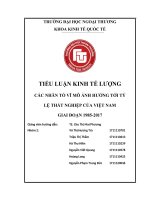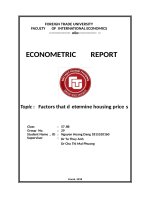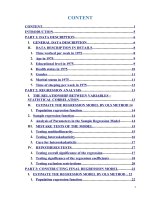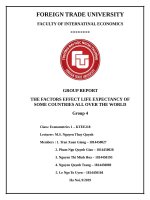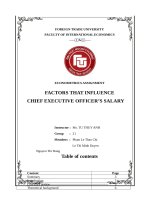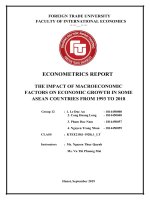tiểu luận kinh tế lượng FACTORS THAT AFFECT UNEMPLOYMENT RATE OF 53 COUNTRIES IN THE WORLD
Bạn đang xem bản rút gọn của tài liệu. Xem và tải ngay bản đầy đủ của tài liệu tại đây (229.42 KB, 24 trang )
FOREIGN TRADE UNIVERSITY
FACULTY OF INTERNATIONAL ECONOMICS
---------***--------
ECONOMETRICS REPORT
FACTORS THAT AFFECT UNEMPLOYMENT RATE OF
53 COUNTRIES IN THE WORLD
Lecturer
: Dr. Tu Thuy Anh
Group members :
Ha Phan Minh Anh - 1810520149
Le Thi Hong Ngoc - 1815520210
Nguyen Huong Lan - 1815520183
Hanoi, October 10th 2019
1
Table of Contents
INTRODUCTION
I.
OBJECTS
In this day and age, unemployment has become a seriously worrying trend to the
entire world. It is not only the dilemma of the youth but also the major concern of
each and every country in the world. Unemployment leads to severe consequences,
which includes people’s low income, struggling ways of life, stagnant growth of
the economy, economy regression problems, increasing the rate of society’s
vices…
According to the report of the General Statistics Office of Vietnam, the
unemployment rate of Vietnam in the third quarter of 2018 was 2.2%, which had
slightly risen compared to that of the second quarter (2.17%) and the first quarter
(2.1%). Nonetheless, it is expected that the unemployment rate of Vietnam is likely
to experience a decrease, which is a good sign for the general economy. The World
Bank published statistical database of high unemployment rate of some countries
such as South Africa (27.33%) or North Macedonia (22%). In contrast, some
countries in the world have rather low unemployment rate which is approximately
0% such as Qatar (0.14%) or Laos (0.6%). What are the reasons that created such a
huge discrepancy? The purpose of this report mainly focuses on answering this
question. We will provide some insights and statistical research to examine how
factors such as the annual GDP growth rate, the annual population growth rate, the
inflation rate… influence the unemployment rate of some countries in the world.
II. WHY DO WE CHOOSE THIS TOPIC?
With a view to find out the factors that create massive impacts on the
unemployment rate of 53 selected countries in the world as well as propose
appropriate resolutions and recommendations to reduce the unemployment rate in
those countries, including Vietnam, we decided to choose the topic of “Factors that
affect unemployment rate of 53 countries in the world”. This topic is among the
widespread concern of people and nations all around the world and the practical
resolutions are at issue and need to be clarified and executed, which makes it a
suitable topic to do research about. There have been many reports analyzing this
topic but our observations in the selected countries would bring about new
discoveries and show the latest trends and examine possible resolutions. To
conduct the research, we will use quantitative methods, which requires the data of
indexes of 53 countries all over the world, which was collected from the website of
World Bank.
2
LITERATURE REVIEW
I. BASIC CONCEPTS OF UNEMPLOYMENT, UNEMPOYMENT RATE
1. Definitions of Unemployment
Unemployment is defined by the Bureau of Labor Statistics as people who do not
have a job, have actively looked for work in the past four weeks, and are currently
available for work. To indicate the number of unemployed people in an economy,
we use the unemployment rate. It is an indicator that shows the general
unemployment condition of a country.
To precisely calculate the unemployment rate, we need to clearly differentiate the
following definitions:
•
People in their working age are the people who have the right to work in
accordance with the regulations in the Constitution.
•
Labor force is the number of people in their working age who are employed or
searching for employment.
•
Unemployed people are people who are not employed but actively looking for
jobs.
•
Other than people who are employed and unemployed, those who are in their
working age are considered people who are not in the labor force including: students,
housewives, disabled people who do not have the ability to work and those who are not
searching for employment with different reasons.
•
The unemployment rate is defined as the percentage of unemployed workers in the
total labor force.
unemployment rate = 100% x number of unemployed workers total labor force
•
The natural rate of unemployment is defined as the equilibrium rate of
unemployment i.e. the rate of unemployment where real wages have found their free
market level and where the aggregate supply of labor is in balance with the aggregate
demand for labor.
2. Classification
2.1. Types of unemployment
Unemployment is a burden. We need to find out where this burden is, in what kind
of community, occupation, gender, age… to understand the characteristics, to what
extent does it influence the economy and related problems. We have the following
classifications:
3
Gender (male/female)
•
Age
•
Region (urban/rural area)
•
Occupation (economic, agricultural…)
•
Ethnicity
2.2. Reasons of unemployment
•
Quitting jobs (resigning from a job due to different reasons such as low wage…)
•
Losing jobs (being fired from a job due to difficulties…)
•
New entrant: having just encountered the labor force but not having a job yet
(young adults looking for a job, graduated students waiting to start their jobs…)
•
Returning: people who left the labor force but have just returned to search for
employment.
It can be seen that the unemployment rate is just a temporary number. It always
fluctuates. Continuous unemployment status usually happens in an undeveloped
and stagnant economy.
•
2.3. Sources of unemployment
•
Frictional unemployment: happens when a worker is looking for a job or a better
job (higher salary, a closer workplace)
•
Structural unemployment: a form of involuntary unemployment caused by a
mismatch between the skills that workers in the economy can offer, and the skills
demanded of workers by employers (also known as the skills gap). If structural
unemployment is not addressed, it can increase the unemployment rate long after a
recession is over and can increase the natural rate of unemployment.
•
Cyclical unemployment is the contribution of economic recessionary or
expansionary conditions to the total unemployment rate. Cyclical unemployment rises
during recessions and falls during economic expansions and is a major focus of economic
policy.
II. RELATED RESEARCHES
Based on the research that we have read, there are three main groups of researches:
•
•
•
•
•
•
•
The effect of real exchange rate on unemployment
The effect of population growth on unemployment
The effect of Foreign direct Investment on unemployment
1. The effect of real exchange rate on unemployment
Name of the research: “The effect of real exchange rate on unemployment”
Authors: Zahra Bakhshi, Mehrzad Ebrahimi
Publish year: 13/04/2016 - AIMI Magazine
Results of the research:
The series of unemployment reality in many countries in the world
including Iran are due to many reasons. In the research, there are four independent
4
•
•
•
•
•
variables which are exchange rate fluctuations, export, import and gross domestic
product (GDP). The authors used the Lag model with 5 variables which are
unemployment rate, exchange rate fluctuations, export, import and GDP. The
results of the research proved that in the long term as well as short term, GDP had
remarkably positive effects on unemployment; exchange rate had remarkably
negative effects on unemployment; there was no significant correlation between
unemployment and other variables of the research including export and import.
Faults of the research:
Other factors that could have a remarkable effect on unemployment were not taken
into consideration in this research. Besides, the effects of real exchange rate on
unemployment were not specifically evaluated, which was shown in the fact that
the authors did not examine if the exchange rate had direct or indirect effect on
unemployment. If it did have a single indirect effect, it means that the exchange
rate affected other factors and those factors would then affect unemployment.
2. Effect of population growth on unemployment
Name of the research: “Impact of population growth on unemployment in Nigeria”
Author: Habiba Edward Gideon
Publish year: 2017
Results of the research:
This research used multiple regression model and data from 2007-2016, which
shows the same-dimensional relationship between the unemployment rate and
population. As it can be observed, almost economies which have significant
population growth do not have the relative growth in the ability to utilize the
human resource, which leads to high unemployment rate and underdevelopment.
Despite this fact, the effects relating to this can be positive or negative, which
depends on some factors such as firm government, which can bring out the
sustainable growth and development of the country. The key factors to resolute
these problems might be resources, technology and capital (according to John
O.Aiyedogbon, 2012). If these problems are not taken into consideration and
addressed thoroughly, they might be the destructive dilemma of the country.
3. Effect of Foreign Direct Investment on unemployment
Research 1:
Name of the research: “Impact of Foreign Direct Investment (FDI) on the
Unemployment Rate in Malaysia”
•
Authors: Hamidah Muhd Irpan, Rosfadzimi Mat Saad, Abu Hassan Shaari Md Nor,
Abd Halim Md Noor, and Noorazilah Ibrahim.
•
Publish year: 2016, Journal of Physics: Conference Series.
•
Result of the research:
This research used the data of the period of time from 1982-2012 of Malaysia,
which shows the dimensional relationship between the unemployment rate and the
FDI. Specifically, when FDI increases in the long term, the unemployment rate
•
5
decreases and this relationship is even more obvious in the short term. This
research also concluded that a country needs to attract FDI from foreign countries
to decrease the unemployment rate. The reason is that FDI can decrease the
national product shortage and human resources wastes.
Research 2:
•
Name of the research: “Impact of Foreign Direct Investment on Unemployment
rate in Nigeria (1980-2015)”
•
Authors: Nelson Johnny, Ekokeme Tamaroukro Timipere, Okoyan Krokeme, and
Dumani Markjackson.
•
Publish year: 2018 - Human Resource Management Academic Research Society
(www.hrmars.com)
•
Results of the research:
This research used the multiple regression model with the data of the period of
time from 1980 - 2015 of Nigeria, which shows the inverse relationship between
the unemployment rate and FDI. Specifically, when FDI increases, unemployment
rate decreases. The Neo liberal school stated that via FDI, most of the economic
properties can be achieved. It can provide developing countries with crucial
support in the process of industrial modernization. The results show that to
remarkably decrease the unemployment rate, the core of the policies needs some
strategies to attract FDI.
6
METHODOLOGY
I. Model and data
1. Model
To test the influence of factors on the unemployment rate, the team applied the
theoretical basis and proposed the following mathematical model:
(PRF): Y=β1+β2ggdp+β3gpop+β4inf+β5fdi+β6er+µi
(SRF): Y^i=β^1+β^2ggdp+β^3gpop+β^4inf+β^5fdi+β^6er+ei
2. Data
a. Describe the variables
Name of
variable
Dependent
variables
Independent
variable
Unit of variable
Explanatory variables
une
%
Unemployment rate
ggdp
gpop
%
%
inf
fdi
%
%
er
%
Annual GDP growth rate
Annual population growth
rate
Inflation rate
Foreign Direct Investment
rate
Exchange rate
b. Describe the data
Collected data shows information of basic factors related to unemployment
rate: unemployment rate, annual GDP growth rate, annual population growth rate,
inflation rate, foreign direct investment rate and exchange rate
Data collections: We use data sources on indexes of 53 countries in the
world which are collected on World Bank – a verified source that is highly accurate
and run model in Gretl Software.
II. SUMMARY STATISTICS AND CORRELATION MATRIX
1. Summary statistics
Summary Statistics, using the observations 1 – 53
Variable
une
ggdp
gpop
Mean
6.88
3.31
0.972
Median
4.90
2.76
1.02
S.D.
5.48
2.32
0.916
7
Min
0.140
-2.07
-1.20
Max
27.3
8.67
2.89
inf
fdi
er
2.54
2.96
1.62e+00
3
2.13
2.46
18.5
1.68
2.64
5.76e+00
3
-0.181
-2.62
0.777
7.44
9.49
3.32e+004
Comments:
According to the data collected from the above table, we can realize:
Annual GDP growth rate
Annual population growth rate
Inflation rate
Foreign Direct Investment rate
Exchange rate
Unemployment rate
Min
-2.07
-1.20
-0.181
-2.62
0.777
0.140
Max
8.67
2.89
7.44
9.49
3.32e+004
27.3
Median
2.76
1.02
2.13
2.46
18.5
4.9
2. Correlation Matrix
Correlation coefficients, using the observations 1 - 53
5% critical value (two-tailed) = 0.2706 for n = 53
une
1.0000
ggdp
-0.6212
1.0000
gpop
-0.3282
0.2115
1.0000
inf
-0.3591
0.2765
-0.0785
1.0000
fdi
-0.5049
0.5221
0.2677
0.0040
1.0000
une
ggdp
gpop
inf
fdi
-0.0177
0.1059
0.0503
0.0075
0.0687
1.0000
une
ggdp
gpop
inf
fdi
er
er
Correlation of dependent variable vs independent variables:
● Cor(une,fdi) = -0.5049 → The correlation between Unemployment rate and FDI
is not at the same dimension, with the percentage of -50.49%
8
● Cor(une,inf) = -0.3591 → The correlation between Unemployment rate and
Inflation is not at the same dimension, with the percentage of -35.91%
● Cor(une,gpop) = -0.3282 → The correlation between Unemployment rate and
Annual population growth rate is not at the same dimension, with the percentage of
-32.82%
● Cor(une,ggdp) = -0.6212 → The correlation between Unemployment rate and
Annual GDP growth rate is not at the same dimension, with the percentage of
-62.12%
● Cor(une,er) = -0.0177 → The correlation between Unemployment rate and
Exchange rate is not at the same dimension, with the percentage of -1.77%
Comments: In general, the independent variables are correlated with the dependent
variable is not high, especially the “er” variable has a very low correlation
coefficient, just more than 1%. In addition, the independent variables have
negative correlation coefficients, in the opposite dimension on the dependent
variables.
Correlation of independent variables vs independent variables:
● Cor(fdi,inf) = 0.0040
● Cor(fdi,gpop) = 0.2677
● Cor(fdi,ggdp) = 0.5221
● Cor(fdi,er) = 0.0687
● Cor(inf,ggdp) = 0.2765
● Cor(inf,gpop) = -0.0785
● Cor(inf,er) = 0.0075
● Cor(gpop,ggdp) = 0.2115
● Cor(gpop,er) = 0.0503
● Cor(ggdp,er) = 0.1059
Comments: Because the correlation coefficients between the independent variables
are less than 0.8 and all correlation coefficients of the variables are less than 0.9,
we can predict the model will not have multi-collinearity when model defects test
III. TEST AND INFERENCE
1. Estimation
Model 5: OLS, using observations 1-53
Dependent variable: une
9
const
ggdp
gpop
inf
fdi
er
Coefficient
14.7552
−0.885627
−1.22137
−0.885313
−0.534428
4.93634e-05
Mean dependent var
Sum squared resid
R-squared
F(5, 47)
Log-likelihood
Schwarz criterion
Std. Error
1.29792
0.297469
0.630978
0.349080
0.251745
9.61157e-05
6.883262
740.5674
0.525811
10.42333
−145.0875
313.9968
t-ratio
11.37
−2.977
−1.936
−2.536
−2.123
0.5136
S.D. dependent var
S.E. of regression
Adjusted R-squared
P-value(F)
Akaike criterion
Hannan-Quinn
p-value
<0.0001
0.0046
0.0589
0.0146
0.0391
0.6099
***
***
*
**
**
5.480309
3.969478
0.475366
9.05e-07
302.1751
306.7212
Describe the basic content of the value when estimating the function:
After running the regression model using Gretl software, we have summarized the
results in the following table:
Variable
Coefficient
14.7552
ggdp
−0.885627
t-ratio
P-Value
11.37
<0.0001
−2.977
0.0046
gpop
−1.22137
−1.936
0.0589
inf
−0.885313
−2.536
0.0146
fdi
−0.534428
−2.123
0.0391
er
4.93634e-05
0.5136
0.6099
Thus, the sample regression function expressing the influence of factors on the
unemployment rate has the form:
Meaning of estimation coefficients :
Ceteris paribus, when the annual GDP growth rate increased by 1%, the
unemployment rate decreased by 88.5627%
Ceteris paribus, when the annual population growth rate increased by 1%, the
unemployment rate decreased by 122,137%
10
Ceteris paribus, when inflation rate increased by 1%, the unemployment rate
decreased by 88.5313%
Ceteris paribus, when FDI increased by 1%, the unemployment rate decreased by
53.4428%
Ceteris paribus, when exchange rate increased by 1%, the unemployment
decreased by 4.93634e-05%
Analysis of regression results:
- Number of observations for analysis: 53
- Number of variables of the model: 6
- The degrees of freedom of the model: 53 - 6 = 47
- The relevance of the model compared to the fact that R2 = 0.525811 shows that
the independent variables explain about 52.5811% of the change of the dependent
variables. This factor is sufficient to ensure a certain level of confidence in the
selected model.
- Looking at the results table, we see that, although estimates and models cannot be
absolutely accurate, with a certain degree of confidence, we can fully conclude that
the unemployment rate depends on the following factors: the annual GDP growth
rate, the annual population growth rate, the inflation rate, the FDI growth rate, the
exchange rate.
2. Multicollinearity
a. Definition
In statistics multicollinearity (also collinearity) is a phenomenon in which one
predictor variable in a multiple regression model can be linearly predicted from
the others with a substantial degree of accuracy. In this situation the coefficient
estimates of the multiple regression may change erratically in response to small
changes in the model or the data. Multicollinearity does not reduce the predictive
power or reliability of the model as a whole, at least within the sample data set; it
only affects calculations regarding individual predictors. That is, a multivariate
regression model with collinear predictors can indicate how well the entire bundle
of predictors predicts the outcome variable, but it may not give valid results about
any individual predictor, or about which predictors are redundant with respect to
others.
Note that in statements of the assumptions underlying regression analyses such as
ordinary least squares, the phrase "no multicollinearity" is sometimes used to
11
mean the absence of perfect multicollinearity, which is an exact (non-stochastic)
linear relation among the regressors.
b. Check
VIF stands for Variance Inflation Factor. During regression analysis, VIF
assesses whether factors are correlated to each other (multicollinearity), which
could affect p-values and the model isn’t going to be as reliable.
If a VIF is greater than 10, we have high multicollinearity and the variation will
seem larger and the factor will appear to be more influential than it is. If VIF is
closer to 1, then the model is much stronger, as the factors are not impacted by
correlation with other factors.
Running on Gretl, we have:
Variance Inflation Factors
Minimum possible value = 1.0
Values > 10.0 may indicate a collinearity problem
ggdp
gpop
inf
fdi
er
1.566
1.101
1.131
1.457
1.013
In the collinearity test, we can see that the Variance Inflation Factors of both
variables are below 10. So that this model doesn’t have collinearity.
3. Normality
a. Definition
In statistics, normality tests are used to determine if a data set is well-modeled by a
normal distribution and to compute how likely it is for a random variable
underlying the data set to be normally distributed.
b.
Hypothesis:
12
According to this graph, chi-squared equals to 7.342, The p-value equals to
0.0255, equivalent to 2.55% < 5% → Reject H0
However, the observations are enough so that we don’t have to fix
4. Autocorrelation
Because the data is in cross-sessional format so that this model doesn’t have
collinearity.
5. Heteroscedasticity
a. Definition
According to Wikipedia, in statistics, a collection of random variables is
heteroscedastic (or heteroskedastic from Ancient Greek hetero “different” and
skedasis “dispersion”) if there are sub-populations that have different variabilities
from others. Here "variability" could be quantified by the variance or any other
measure of statistical dispersion. Thus, heteroscedasticity is the absence of
homoscedasticity.
The existence of heteroscedasticity is a major concern in the application of
regression analysis, including the analysis of variance, as it can invalidate
13
statistical tests of significance that assume that the modelling errors are
uncorrelated and uniform—hence that their variances do not vary with the effects
being modeled. For instance, while the ordinary least squares estimator is still
unbiased in the presence of heteroscedasticity, it is inefficient because the true
variance and covariance are underestimated. Similarly, in testing for differences
between sub-populations using a location test, some standard tests assume that
variances within groups are equal.
b. Check
In order to know whether our model is heteroscedasticity or not, we use White’s
test.
Hypothesis
(If is rejected, our model is heteroscedasticity)
Running on Gretl, we have:
Unadjusted R-squared = 0.709476
Test statistic: TR^2 = 37.602233,
with p-value = P (Chi-squared (20) > 37.602233) = 0.009900
Conclusion: We have p-value = . With a 5% significance level, heteroscedasticity
is presented.
Continuing fixing on Robust standard errors on Gretl, we have:
Model 5: OLS, using observations 1-53
Dependent variable: une
Heteroskedasticity-robust standard errors, variant HC1
const
ggdp
gpop
inf
fdi
er
Coefficient
14.7552
−0.885627
−1.22137
−0.885313
−0.534428
4.93634e05
Mean dependent var
Sum squared resid
R-squared
F(5, 47)
Std. Error
1.95765
0.289391
0.662400
0.303301
0.199142
2.81492e05
(Exhibit 5.b.1)
6.883262
740.5674
0.525811
8.040151
t-ratio
7.537
−3.060
−1.844
−2.919
−2.684
1.754
S.D. dependent var
S.E. of regression
Adjusted R-squared
P-value(F)
14
p-value
<0.0001
0.0036
0.0715
0.0054
0.0100
0.0860
***
***
*
***
**
*
5.480309
3.969478
0.475366
0.000015
Log-likelihood
Schwarz criterion
−145.0875
313.9968
Akaike criterion
Hannan-Quinn
302.1751
306.7212
Conclusion: Using Robust will make the estimations more accurate, as the Std.
Error and p-value changed.
6. Testing hypothesis
6.1: Intercept and Coefficients
0
- Hypothesis: H : β0 = 0
0
Alternative hypothesis: H : β0 ≠ 0
1
ts= 1,96
tob= -5,64
The absolute value of tob is less than ts so we reject H : β0 = 0
P-value < 0.05
o
=> β0 has meaning in the model
(ggdp)
- Hypothesis: :
Alternative hypothesis: : ≠ 0
- From the result on Exhibit 5.b.1, we see the p-value = 0.0036 < α = 0.05
=> We have enough evidence to reject Ho => B1 is statistically significant
(gpop)
- Hypothesis: Ho:
Alternative hypothesis: : ≠ 0
- From the result on Exhibit 5.b.1, we see the p-value = 0.0715 > α = 0.05
=> We do not have enough evidence to reject Ho => is not statistically significant
(inf)
- Hypothesis: Ho:
Alternative hypothesis: : ≠ 0
15
- From the result on Exhibit 5.b.1, we see the p-value = 0.0054 < α = 0.05
=> We have enough evidence to reject Ho => is statistically significant
(fdi)
- Hypothesis: H0:
Alternative hypothesis: : ≠ 0
- From the result on Exhibit 5.b.1, we see the p-value = 0.0100 < α = 0.05
=> We have enough evidence to reject Ho => is statistically significant
(er)
- Hypothesis: H0:
Alternative hypothesis: : ≠ 0
- From the result on Exhibit 5.b.1, we see the p-value = 0.0860 > α = 0.05
=> We have enough evidence to reject Ho => is not statistically significant
6.2 : Testing the overall significance
- Null hypothesis: :
Alternative hypothesis: H1: 2 + 2 + 2 + 2 + 2 ≠ 0
- p-value (F) = 0.000015 < 0.05
=> We have enough evidence to reject Ho
=> The model is suitable.
16
RECOMMENDATION
Based on the surveys and research the factors that affect the unemployment rate of
53 countries in the world in 2017, we have figured out many things we did not
expected from the very beginning and we would want to suggest some possible
solutions to the aforementioned problems of 53 countries including Vietnam to
decrease the unemployment rate:
Firstly, about GDP growth rate, all the countries need to stimulate economic
growth:
•
About the fiscal year, investment on development needs to be promoted based on
consolidating revenues, extension of income tax payment for enterprises and economic
sectors.
•
About currency, it needs credit interest rate compensation for intermediate and
long-term loans for investment in equipment and facilities in the countries’ economy and
in the agriculture sector and so on.
•
Stimulate growth by stimulus
•
In Vietnam:
•
Give enterprises and businesses in each and every sector of the economy the
support to participate in investing in projects, large scale construction, create job
opportunities, support enterprises by tax reduction, tax returns with the commitment of
maintaining jobs for the current labor force and attract labor if necessary, provide loan
support for enterprises to maintain production and guarantee jobs for the workers.
•
Develop the multi-sector economy, attract foreign direct investment for industrial
areas of economic projects to contribute to economic growth and creating job
opportunities for workers.
Secondly, about the foreign direct investment:
•
All countries need to have policies that increase investment funds (that mainly
comes from the national saving, foreign debt) to accelerate the progress of constructing
the infrastructure, irrigation, traffic system… to create job opportunities for the human
resource.
•
Temporarily, the countries need to loosen the financial policies, conduct
administrative reform to attract foreign investment, which would provide employment to
people.
•
Besides, there must be encouragement to develop small and medium business,
capital loans for enterprises to equip facilities and expand production scale.
Thirdly, about population, the countries need appropriate educational programs,
human resource training, labor division reorganization, human resource level
improvement. Every country also needs policies that support the labour in finding
jobs via job consultation centers and improve the unemployment insurance system
and social security.
More than that, about the inflation rate, the countries are conducting
different methods and policies to control the inflation rate. In Vietnam, the
government needs to:
•
Continue maintaining the strict policy of currency
17
Enhance the management of price to keep it suitable to market mechanism;
manage the price of certain products and exclusive services to keep them suitable to the
regulations of international economic integration by market supervision, cost control,
applying tax.
•
Motivate applying technology advancement to increase the competitiveness of the
product.
•
Stimulate the domestic production development.
•
CONCLUSION
18
Unemployment has always been an important dilemma and it has attracted
concerns from many researchers. High rate of unemployment will have negative
influence on individual mindset, enterprise cost and economic growth.
Nonetheless, a moderate number of unemployment rate will encourage the
employees and the employers to increase their productivity and profits. This leads
to the fact that every country including Vietnam are looking for the proper answer
to the question: “How to keep the unemployment rate moderate?”.
Throughout the process of doing overview research, establishing the
theoretical frame, planning and organizing the research, implementing empirical
research, analyzing and processing data, proving, testing and summarizing to find
out the solutions to the problems, we have achieved what we expected to do when
conducting this research assignment. Specifically, this assignment includes
following information:
Firstly, we proved the interrelation between unemployment rate and
determined factors via analyzing the influence with the econometric regression
model. We did research and concluded about the significance of factors such as
Gross Domestic Product growth rate, population growth rate, inflation rate, foreign
direct investment and exchange rate. We have affirmed that determining if each of
these factors has effects on the unemployment rate or not is completely possible
using the quantitative analysis method.
Secondly, with the foundation of what we have figured out from the
research, we have suggested some possible solutions to improve unemployment
rate. Despite the fact that some of the solutions have been applied in some
countries in the world, we have organized the solutions in a clear and specific way
especially with those that can be implemented in Vietnam.
To sum up, we would like to express our gratitude to the lecturer Dr. Tu
Thuy Anh and the available, trustworthy and precise sources of data and researches
as well as others for having supporting us during the Econometrics course and the
process of writing the assignment. Although we have tried our best, there must be
some inevitable mistakes and misunderstanding. Therefore, we will try even harder
in the next research.
REFERENCES
1.
Habiba Edward Gideon, 2017, Impact of population growth on
19
unemployment in Nigeria.
2.
Hamidah Muhd Irpan, Rosfadzimi Mat Saad, Abu Hassan Shaari Md Nor,
Abd Halim Md Noor, and Noorazilah Ibrahim, 2016, Impact of Foreign
Direct Investment on the Unemployment Rate in Malaysia, Journal of
Physics: Conference Series.
3.
Nelson Johnny, Ekokeme Tamaroukro Timipere, Okoyan Krokeme, and
Dumani Markjackson, 2018, Impact of Foreign Direct Investment on
Unemployment rate in Nigeria (1980-2015), Human Resource Management
Academic Research Society.
4.
Zahra Bakhshi, Mehrzad Ebrahimi, 2016, The effect of real exchange rate on
unemployment, AIMI magazine.
General Statistics Office of Vietnam, 2018, Unemployment rate of Vietnam (2018)
Kimberly Amadeo, 2019, Unemployment, its causes, and its consequences,
thebalance.com, />6.
Database source: WorldBank
5.
5.
APPENDIX
Database table:
20
Summary statistics table:
21
Summary Statistics, using the observations 1 – 53
Variable
une
ggdp
gpop
inf
fdi
er
Mean
6.88
3.31
0.972
2.54
2.96
1.62e+00
3
Median
4.90
2.76
1.02
2.13
2.46
18.5
S.D.
5.48
2.32
0.916
1.68
2.64
5.76e+00
3
Min
0.140
-2.07
-1.20
-0.181
-2.62
0.777
Max
27.3
8.67
2.89
7.44
9.49
3.32e+004
Correlation Matrix table
Correlation coefficients, using the observations 1 - 53
5% critical value (two-tailed) = 0.2706 for n = 53
une
1.0000
ggdp
-0.6212
1.0000
gpop
-0.3282
0.2115
1.0000
inf
-0.3591
0.2765
-0.0785
1.0000
fdi
-0.5049
0.5221
0.2677
0.0040
1.0000
une
ggdp
gpop
inf
fdi
-0.0177
0.1059
0.0503
0.0075
0.0687
1.0000
une
ggdp
gpop
inf
fdi
er
er
OLS table:
Model 5: OLS, using observations 1-53
22
Dependent variable: une
const
ggdp
gpop
inf
fdi
er
Coefficient
14.7552
−0.885627
−1.22137
−0.885313
−0.534428
4.93634e-05
Mean dependent var
Sum squared resid
R-squared
F(5, 47)
Log-likelihood
Schwarz criterion
Std. Error
1.29792
0.297469
0.630978
0.349080
0.251745
9.61157e-05
6.883262
740.5674
0.525811
10.42333
−145.0875
313.9968
t-ratio
11.37
−2.977
−1.936
−2.536
−2.123
0.5136
S.D. dependent var
S.E. of regression
Adjusted R-squared
P-value(F)
Akaike criterion
Hannan-Quinn
23
p-value
<0.0001
0.0046
0.0589
0.0146
0.0391
0.6099
***
***
*
**
**
5.480309
3.969478
0.475366
9.05e-07
302.1751
306.7212
